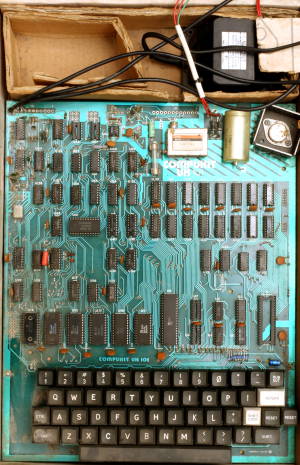|
|
The UK101 Museum |
|
Software Library |
I wrote several programs for the UK101 as well as typing in, modifying and converting many others. Most of them depend to some extent on the extra hardware that I added to my machine, but a few will work without it.
|
|
The Bristol Rest Home for Retired Compukits |

I have three machines in all, my own highly modified one and another two that are nearly original. My machine is a fairly early model with mask ROMs, while the others are later and have EPROMs. Of those other two, one has now been fitted with a 6809 processor chip, as well as new ROMs to suit the 6809 CPU (the modifications are entirely reversible). The remaining machine is by far the most original and unmodified of the three, complete with cardboard box, and will be restored to operation in time for the 30th anniversary of the Compukit in 2009.
Looking at the three machines side-by-side, some minor differences become
apparant.
The most obvious is the use of EPROMs versus mask-programmed ROM chips,
made by Synertec.
But another difference, more subtle, is in the keytops on the keyboard.
My own machine and the EPROM-based machine are identical, but the keyboard
of the 1981 machine is different (see photo).
The key for colon and asterisk is one of the more obvious ones, but in
addition to that, the keys K, L, M and P on the older machines have
symbols on them for use with SHIFT, that is, the square brackets and the
backslash; the newer machine does not have them.
The keyswitches underneath are exactly the same on all three machines.
|
| Compukit Bookshelf |
Along with the machines, I have several relevant magazines
and much technical documentation.
I have the official MOS Technology hardware manual for the
"MCS6500 Microcomputer Family",
Two early third-party manuals are "Programming the 6502" by Rodnay Zaks
(Sybex, 1978-1983) and "6502 Assembly Language Programming" by Lance Leventhal
(Osborne/McGraw Hill, 1979).
Many later books were published specifically for 6502-based machines
(usually the BBC Micro); I have "Creative Assembler" by Jonathan Griffiths
(Penguin Books, 1984).
I also have "Advanced 6502 Interfacing" by John M. Holland (Blacksburg, 1982)
and "6502 Assembly Language Subroutines" by Lance Leventhal and Winthrop Saville
(Osborne/McGraw Hill, 1982).
|
Return to the Compukit UK101 Home Page
Return to John Honniball's home page
Copyright © 1998-2009 by John Honniball. All rights reserved.